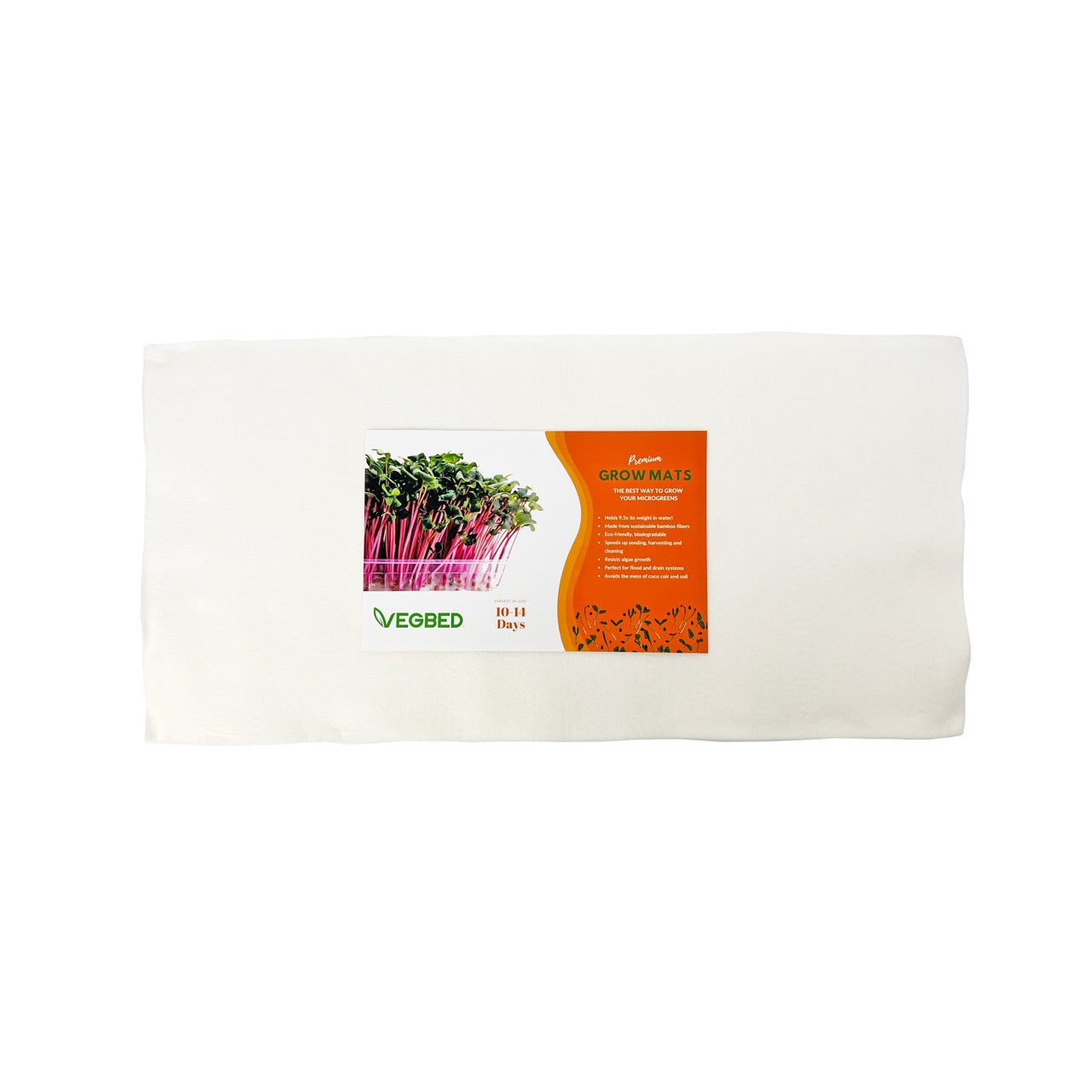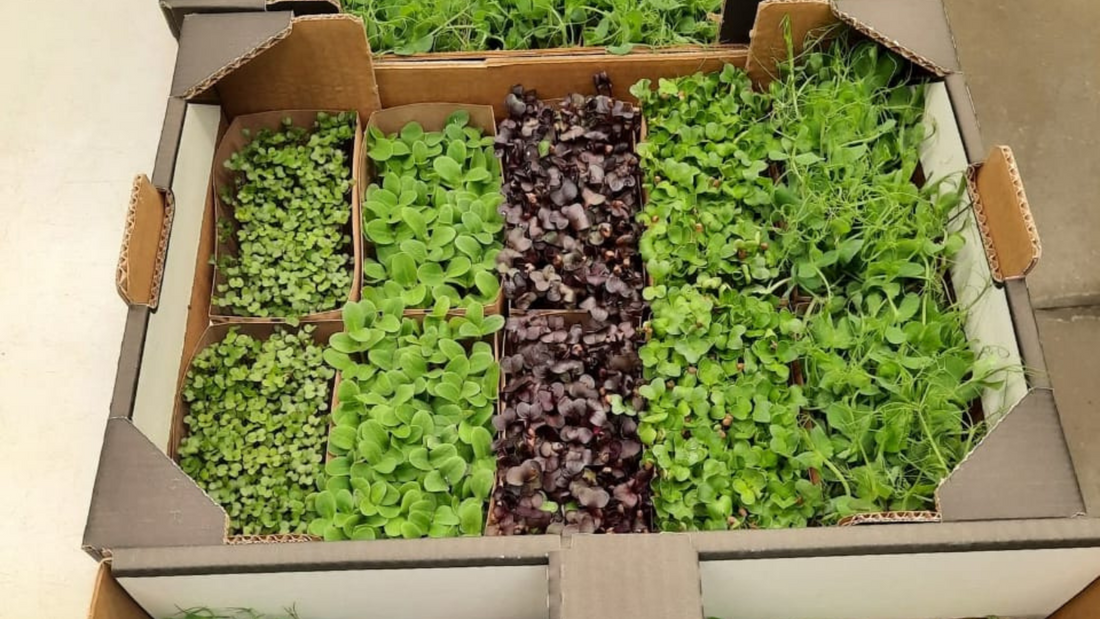Packaging isn’t just protection, it’s your silent salesperson.
Microgreens are small, but their market potential is huge. As more people look for fresh, healthy, and sustainable food, how you package your greens matters. Good packaging grabs attention, shows off your quality, and gets your product ready for shelves.
Whether you’re selling at a grocery store, a local co-op, or the weekend farmers market, your packaging is doing the talking before you even say a word.
Retailers need durability, clarity, and efficiency. Consumers want transparency (literally and figuratively) and a story they can believe in. And for growers, packaging must preserve product integrity while aligning with clean growing practices.
As the microgreens market continues to flourish, leading farms are turning to smarter packaging solutions, and it’s giving them an edge. Here's how they’re doing it, and how you can too. If you’re just starting out, we also recommend reading Turning Your Microgreens Hobby into a Profitable Commercial Operation.
Packaging Strategies That Win in Retail
1. AeroFarms: FlavorSpectrum™ Color-Coding
What they’re doing:
AeroFarms’ FlavorSpectrum™ system matches color-coded packaging to taste profiles, like blue for mild greens and red for spicy. Their large transparent window maximizes visual appeal and trust.
Why it works:
-
✅ Flavor education through design: Color-coding helps shoppers quickly choose based on their taste preferences.
-
✅ Bold retail presence: The consistent visual language across their lineup boosts brand recognition and shelf impact.
-
✅ Maximum visibility: A large, clear window allows the freshness and quality of the greens to do the talking.
-
✅ Award-winning impact: Their strategy earned them Best Brand Marketing at the 2022 Vertical Farming Awards.

AeroFarms FlavorSpectrum microgreens packaging with color-coded labels and a large transparent window, designed to highlight flavor profiles.
2. Little Leaf Farms: Clean Messaging + rPET Clamshells
What they’re doing:
Little Leaf Farms uses clamshells made from 100% recycled plastic and places bold claims front and center—"pesticide-free," “local,” and “pathogen-free.”
Why it works:
-
✅ Recyclable and responsible: The use of 100% recycled material resonates with eco-conscious consumers.
-
✅ Bold, honest labeling: Their emphasis on clean, safe growing practices helps build trust instantly.
-
✅ Clarity sells: The clear clamshell ensures the product speaks for itself on the shelf.
-
✅ Secure yet accessible: Easy to open and reseal, these clamshells are consumer-friendly and practical.
3. Sun Sugar Farms: Cardboard Grow-Through Trays
What they’re doing:
Sun Sugar Farms sells live microgreens in compostable cardboard boxes that double as grow trays, no transplanting or harvesting required by the grower.
Why it works:
-
✅ Zero waste appeal: 100% compostable and plastic-free, aligning with zero-waste shopping trends.
-
✅ Live freshness: Microgreens continue to grow until harvest, enhancing shelf life and reducing spoilage.
-
✅ Interactive experience: Customers get the experience of harvesting their own greens, which increases engagement and value perception.
-
✅ Brandable and versatile: The cardboard surface allows for custom branding and storytelling directly on the packaging.

Sun Sugar Farms compostable cardboard microgreens box with live microgreens growing through the tray, eco-friendly and stackable.
4. ProFarms: Live Microgreens in Retail Trays
What they’re doing:
ProFarms ships live microgreens in open-top, corrugated cardboard trays segmented with kraft-paper liners. Each tray includes several microgreen varieties still actively growing, meant for chefs and bulk buyers.
Why it works:
-
✅ Bulk and variety: Designed for foodservice and culinary professionals who need volume and options.
-
✅ Plastic-free system: The kraft-lined trays are fully compostable and visually align with farm-fresh values.
-
✅ Live greens, no mess: With soil-free substrates, the trays remain clean and easy to handle while the greens stay fresh.
-
✅ Retail or back-of-house ready: Trays are designed for stacking and transport, while still giving customers a premium, fresh-from-the-farm feel.
Why Vegbed Works With Every Packaging Type
Whether you use clamshells, resealable trays, compostable cartons, or grow-through boxes, Vegbed bamboo fiber mats are the perfect substrate to support clean, vibrant microgreens:
-
✨ No soil, no mess: Keeps trays and packaging clean during transport and display.
-
✨ Eco-aligned: Our biodegradable bamboo mats pair seamlessly with compostable and recycled packaging.
-
✨ Consistent performance: Uniform moisture control means better growth and less risk of mold or drying.
For live microgreen trays, like those from Sun Sugar and ProFarms, Vegbed mats eliminate the soil-based mess that often shortens shelf life or compromises presentation.
Whether you’re trimming and packing or selling trays live, Vegbed mats enhance your packaging with cleaner presentation, better performance, and a story that resonates. You can even introduce them into value-added formats like subscription boxes, check out How to Create a Microgreens Subscription Box.
(Learn more: The Benefits of Using Bamboo Fiber Mats for Microgreens)
Key Packaging Takeaways for Retail Success
|
Design Feature |
Why It Matters |
|
Resealable & stackable |
Adds convenience, extends shelf life, and fits store displays |
|
Recycled or compostable |
Aligns with eco-conscious buyer expectations |
|
Clear tray or large window |
Lets product quality speak for itself |
|
Certifications & bold claims |
USDA Organic, “pesticide-free,” etc., boost purchase confidence |
|
Color-coded or branded cues |
Helps shoppers choose by flavor or style |
|
Farm story or origin message |
Connects your values with theirs |
📦 Applying This to Your Farm: How to Package for Growth
Choose packaging that protects and promotes. Select formats that reduce spoilage, stack well, and highlight your greens visually.
Support your claims with clean practices. Using biodegradable, pathogen-free mats supports bold packaging claims like “no soil,” “chemical-free,” and “sustainably grown.”
Tell a short, strong story. Even a small label can say: “Grown on clean bamboo fiber mats. No soil. No mess. Just pure flavor.”
Explore formats that match your market.
-
Farmers markets = Kraft or compostable cartons
-
Retail chains = resealable rPET trays with certification callouts
-
Live microgreens = transparent trays with moisture-retaining media like Vegbed bamboo grow mats
Test packaging in real conditions. Ask: Will it survive transport? Stack without damage? Keep greens vibrant until eaten?
👉 Bonus tip: Check out [Sprouting Opportunities: Proven Marketing Tactics] for more ideas.
What If You Have Overproduction?
Retail packaging doesn’t just support fresh greens—it opens doors for value-added microgreen products. If you overproduce or fresh demand is too low, consider transforming your harvest into:
-
Freeze-dried or powdered microgreens for supplements or cooking
-
🫕 Microgreen pesto, sauces, or dips
-
🌾 Microgreen mixes with labeled nutritional benefits (e.g., high-antioxidant blend)
Great packaging also extends to these categories, especially in resealable pouches or glass jars that protect freshness and communicate premium value.
Don't Forget Storage!
Proper packaging is only one side of freshness. For optimal shelf life and product quality, see our companion article: "How to Store Microgreens for Maximum Freshness", a complete guide on handling, humidity control, and more.
Final Thoughts
Packaging isn’t just a container; it’s a communicator. It tells retailers you’re serious, shows shoppers your product is fresh, and shares your values before anyone even tastes what’s inside.
When paired with Vegbed bamboo grow mats, your microgreens stay cleaner, fresher, and more consistent. That means your packaging performs better, and your product builds loyalty from the first look to the last bite.
From clear clamshells to compostable trays to live grow kits, great packaging starts with what’s underneath. And when overproduction hits, your creativity in processing and product development turns that surplus into profit.
Because in microgreens, quality sells, but presentation seals the deal.



